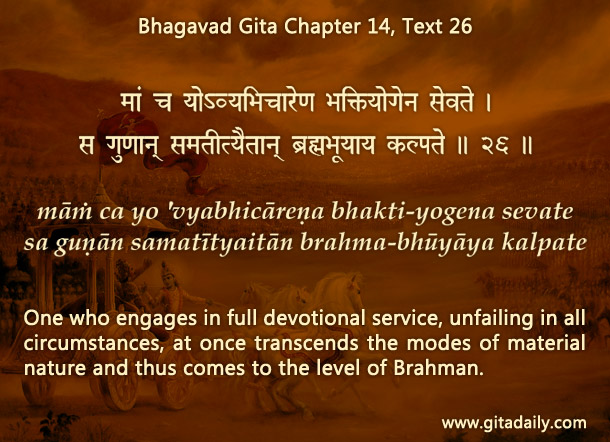On the Kurukshetra battlefield, Arjuna was deviated by the lower modes — under their influence, he was fixating on the agony of fighting against his relatives. When the modes have deviated Arjuna, how can he practice undeviating bhakti-yoga to transcend the modes, as Krishna recommends (14.26)?
Because bhakti-yoga is a connection with the omnipotent Divine, who exists forever beyond the influence of the modes. The stronger our connection with him, the lesser the modes’ disruptive influence on us.
Consider an example. Suppose we have fallen in an ocean and are being tossed about its waves. If we found an anchor steady enough to be unshaken by the waves, then all we would need to do is just hold on to that anchor. The waves would still hit us and may even shake us, but they wouldn’t be able to sweep us away. Bhakti-yoga is a similar anchor that connects us with the unshakeable divinity, Krishna. In fact, bhakti-yoga might be better compared to a ridge that extends to a nearby huge landmass. By holding on to the bhakti-yoga ridge, we could gradually move to the Krishna landmass, thus becoming decreasingly vulnerable to the waves.
Significantly, this verse (14.26) is the only instance in the entire Gita where Krishna uses the compound word bhakti-yoga. Undoubtedly, Krishna uses the term ‘bhakti’ and its variants many times, and he repeatedly recommends the broad process of bhakti-yoga without using that specific term. What might Krishna imply by using here the compound that highlights bhakti as a connection (yoga)? That the connection will empower Arjuna to transcend the modes.
If Arjuna saw fighting not just as his warrior duty (kshatriya dharma), but as his devotional offering to Krishna (bhakti-yoga), then he would focus on the truth that Krishna was the well-wisher of everyone, even those Arjuna was fighting against. By remembering that he was assisting in Krishna’s benevolent plan for those on the opposite side, Arjuna could fight with lesser emotional agitation.
One-sentence summary:
Bhakti-yoga connects us with the One beyond the modes, thereby decreasing their disruptive influence on us.
Think it over:
- How can bhakti-yoga empower us to transcend the modes? Explain with an example.
- What might Krishna’s singular usage of the compound bhakti-yoga imply?
- How would bhakti-yoga decrease Arjuna’s emotional agitation while fighting?
***
14.26: One who engages in full devotional service, unfailing in all circumstances, at once transcends the modes of material nature and thus comes to the level of Brahman.
To know more about this verse, please click on the image


jJAPA is best Bhakti yoga
The richness in expression is very inspiring. Thank You.
Ys,
Happy to be of service.